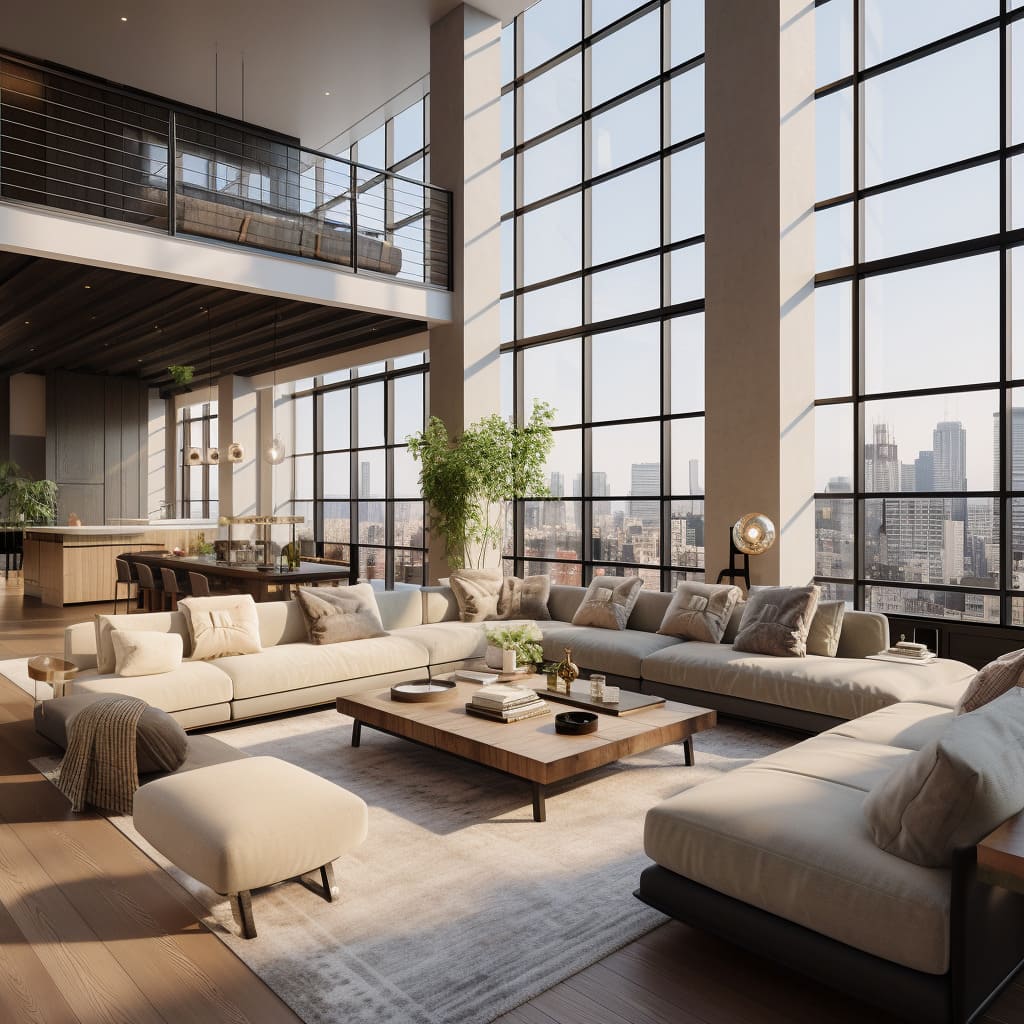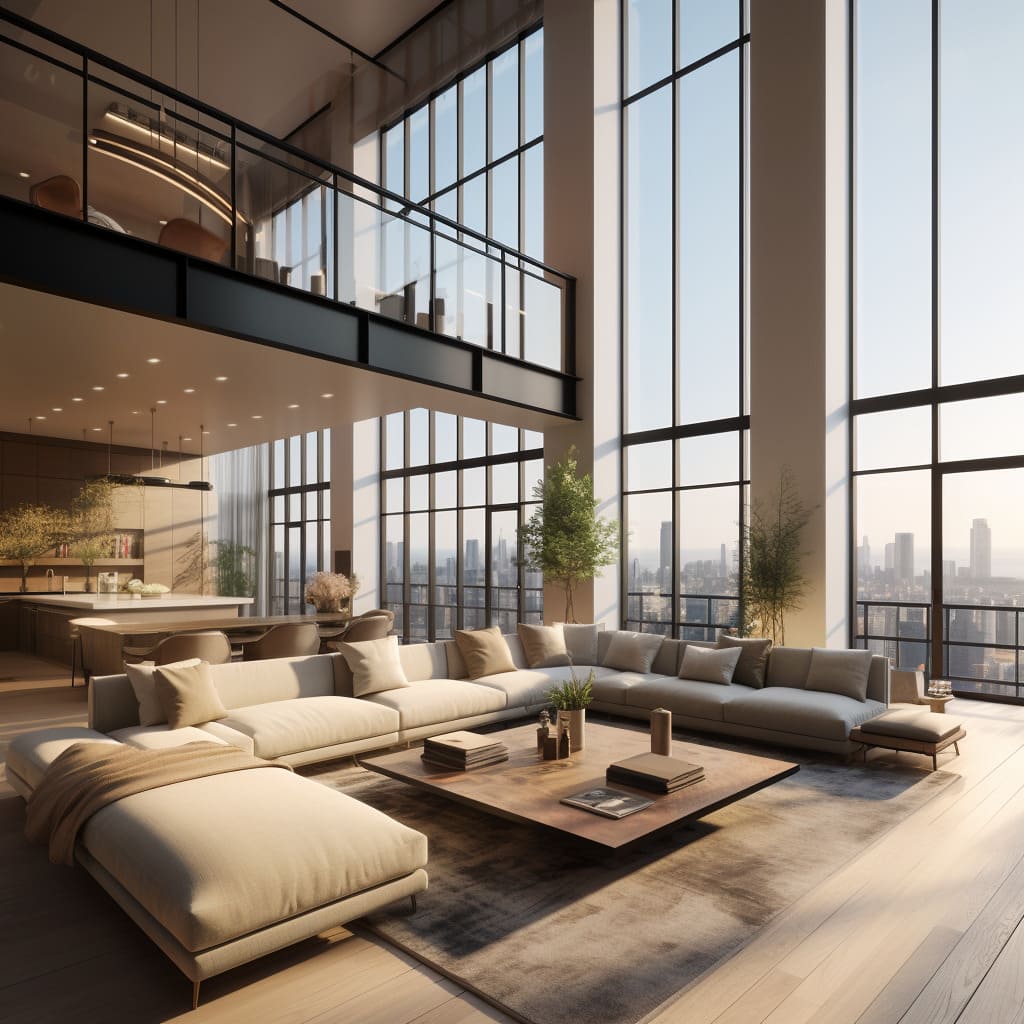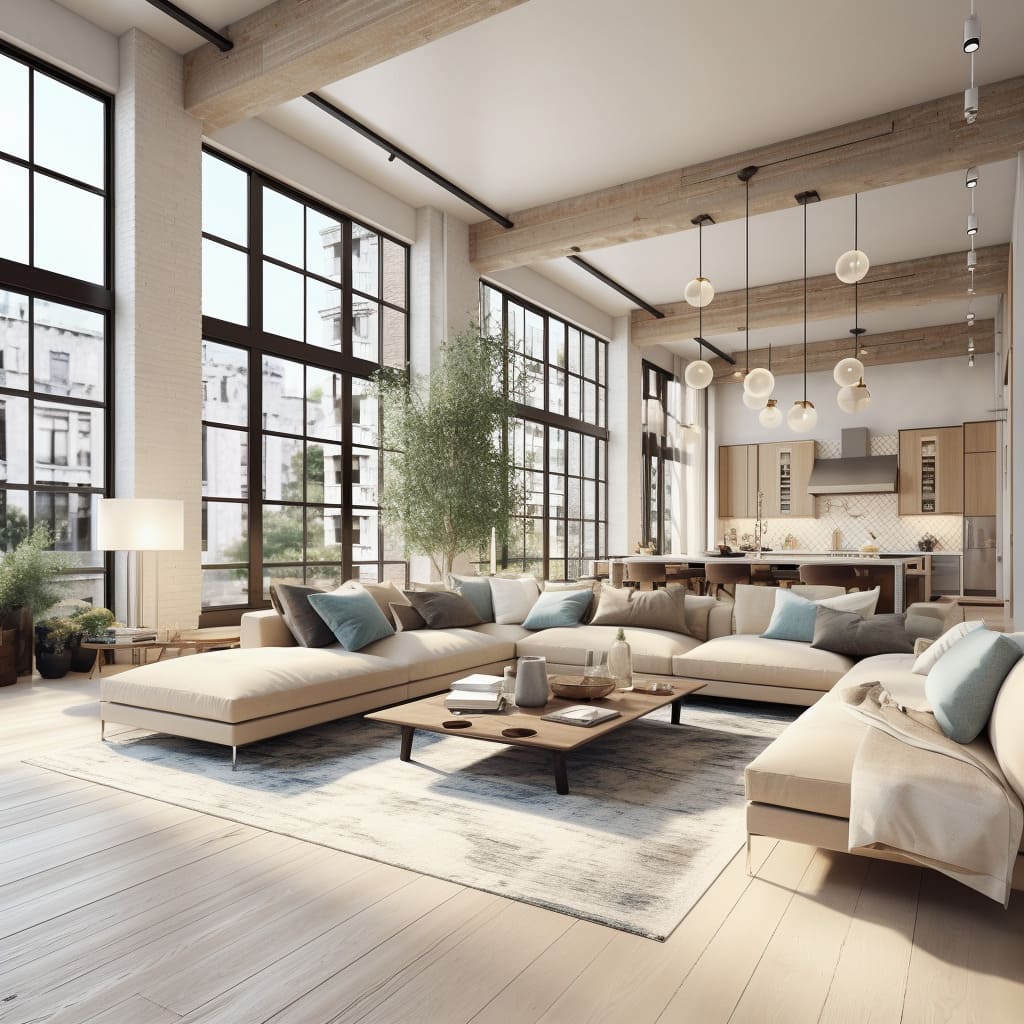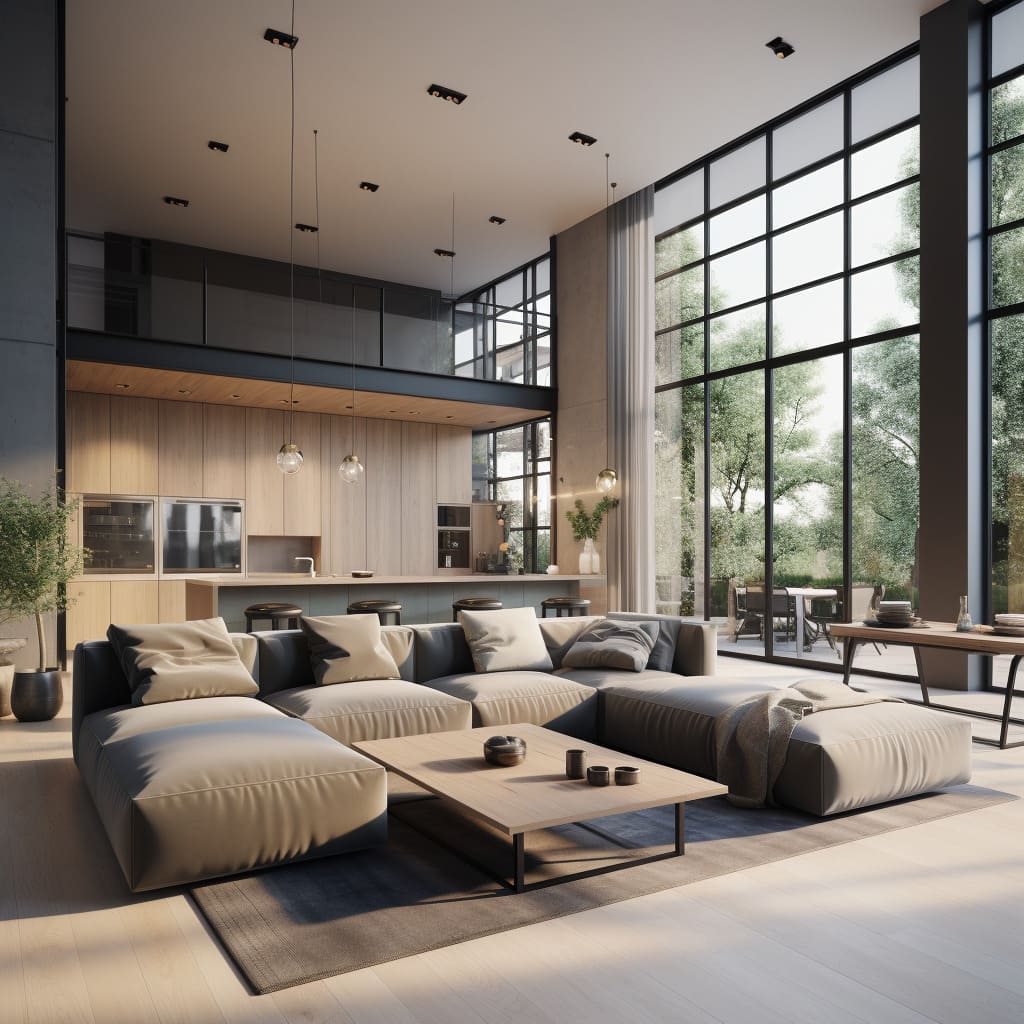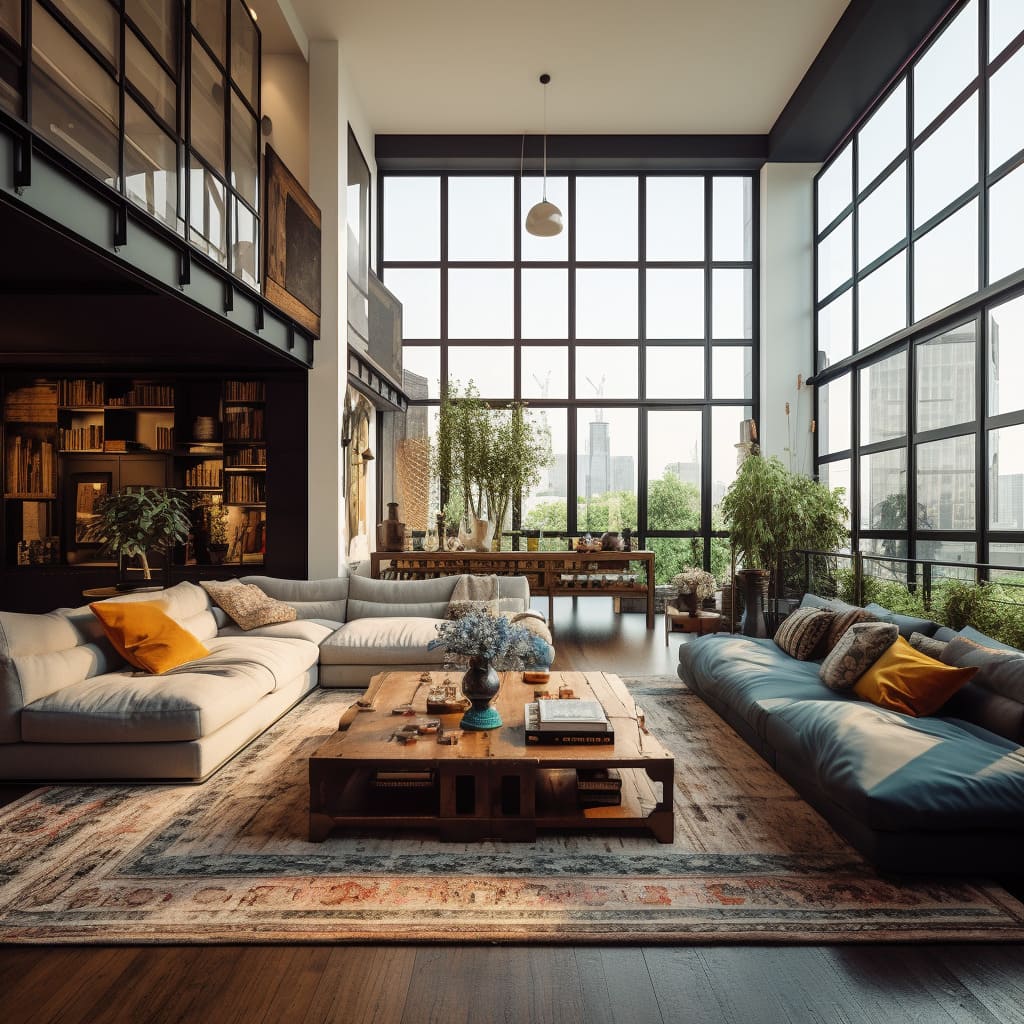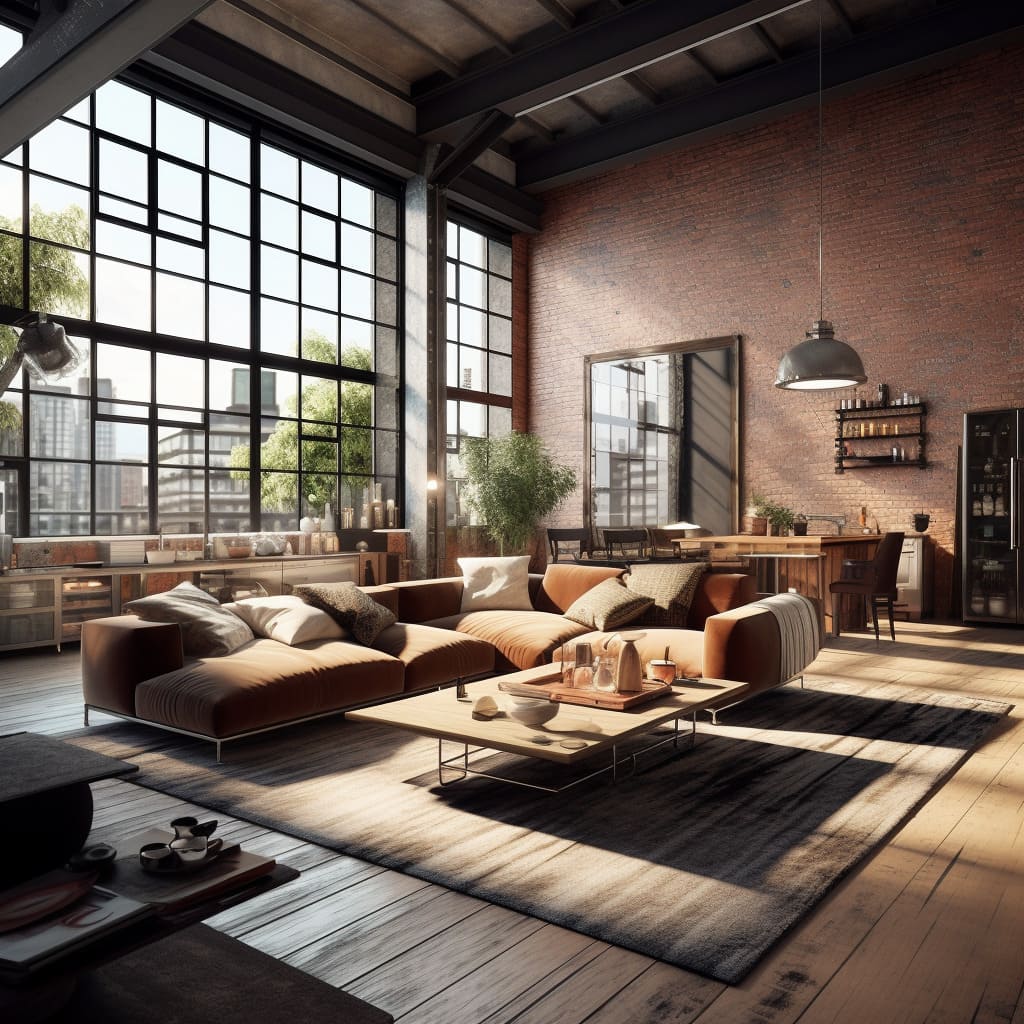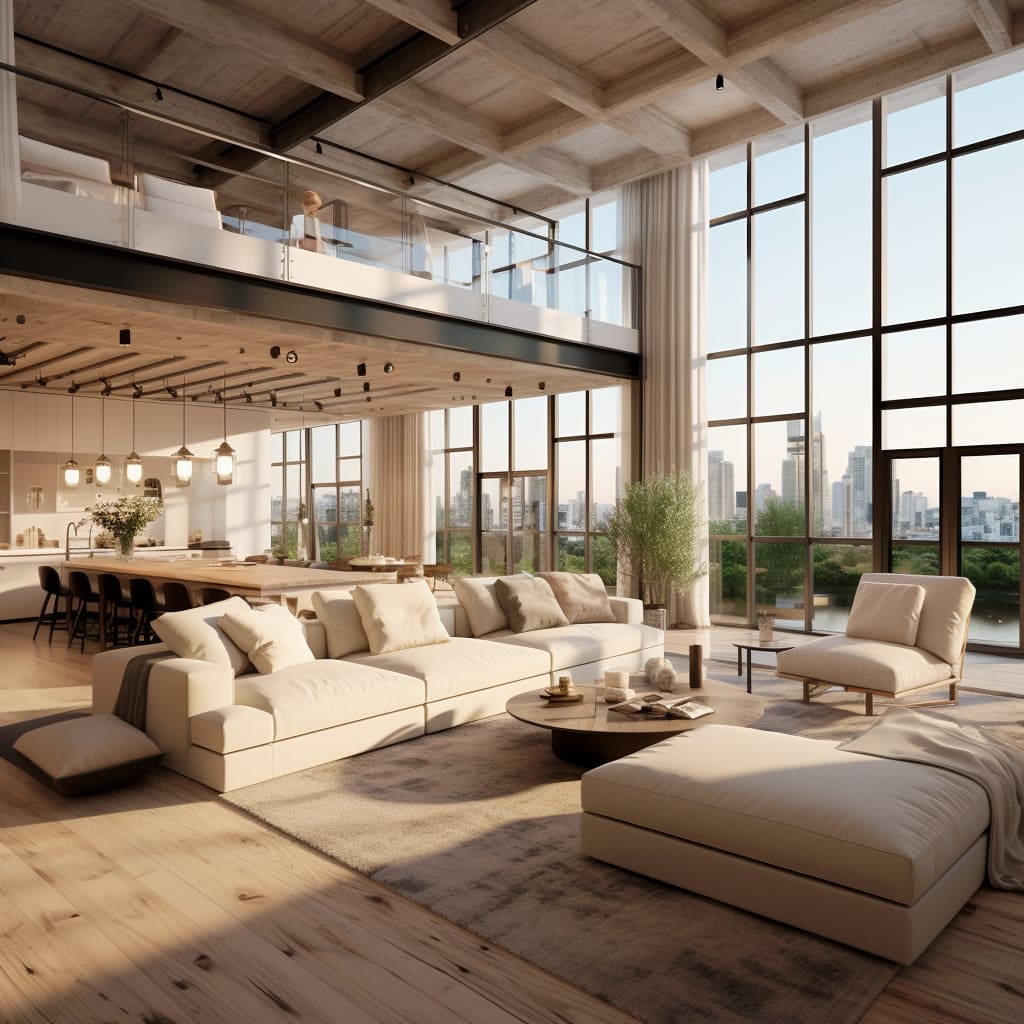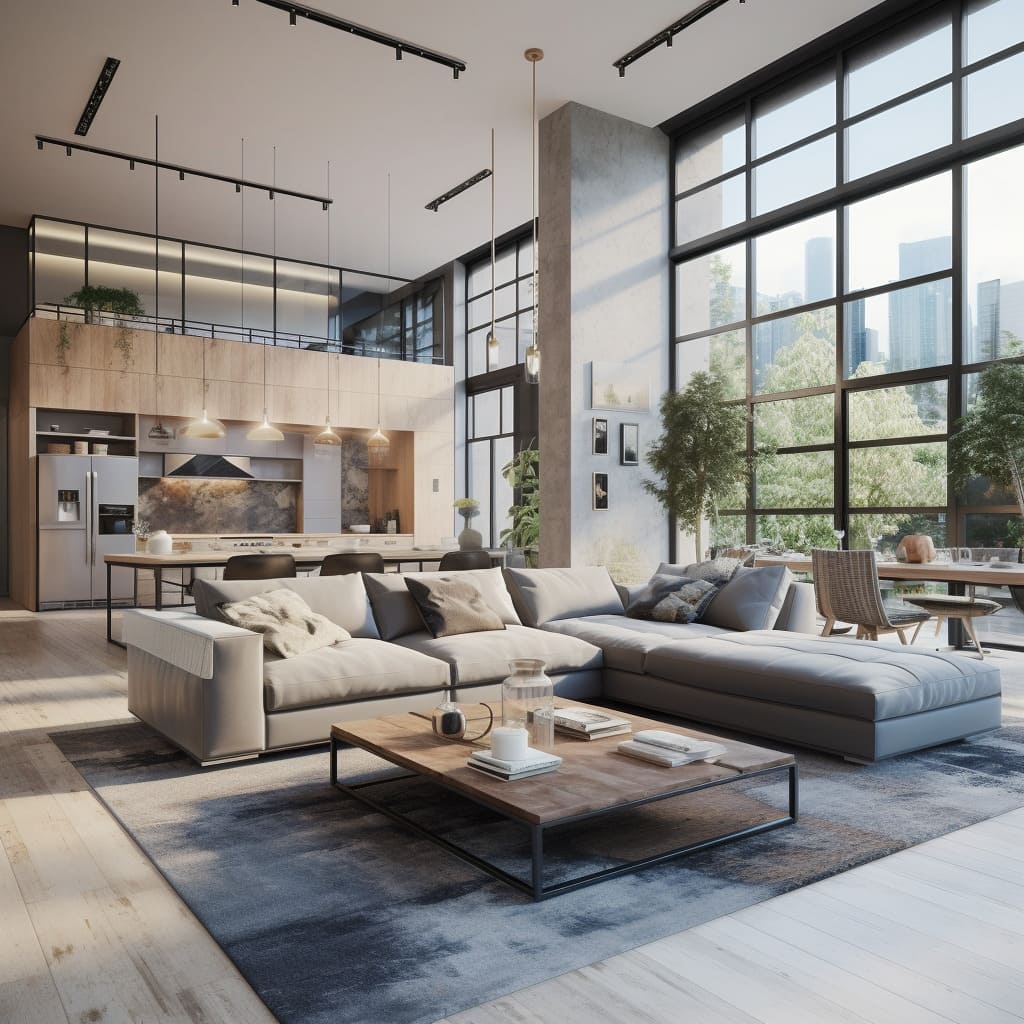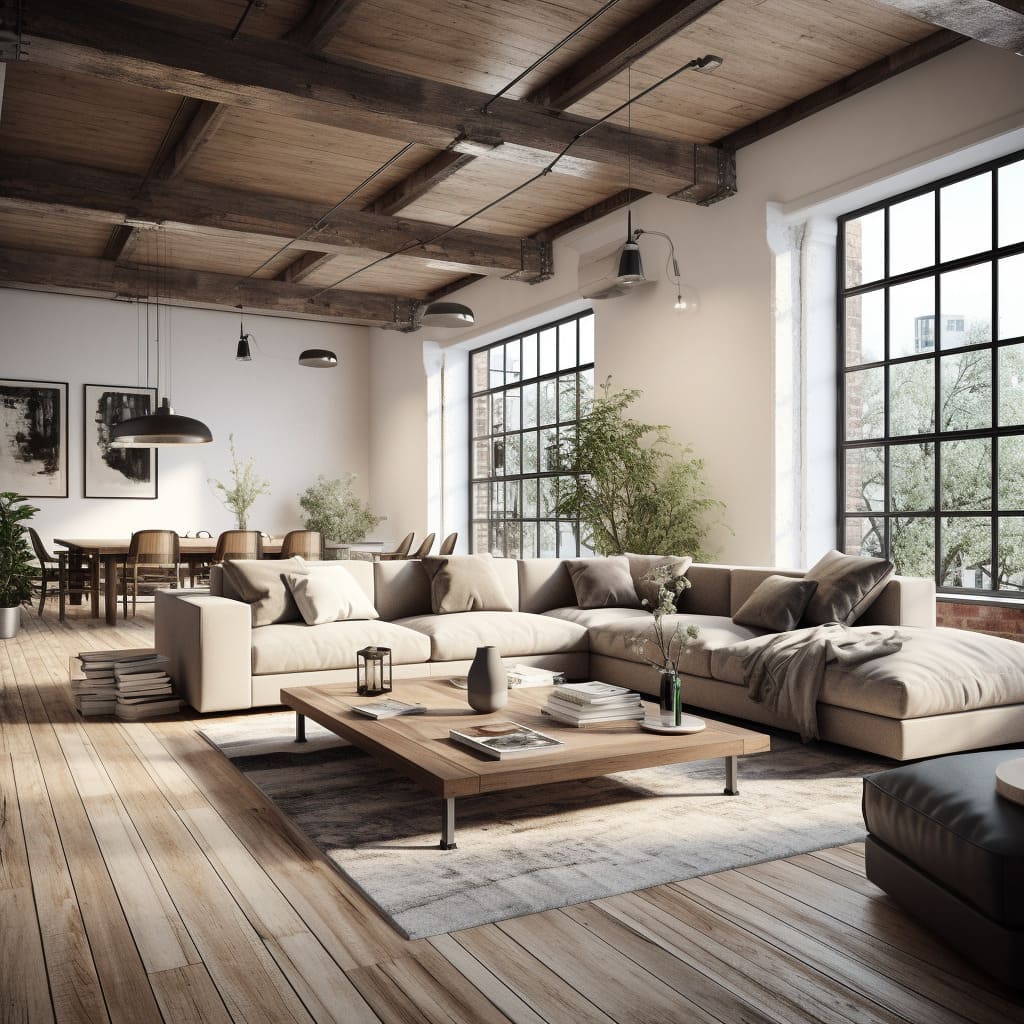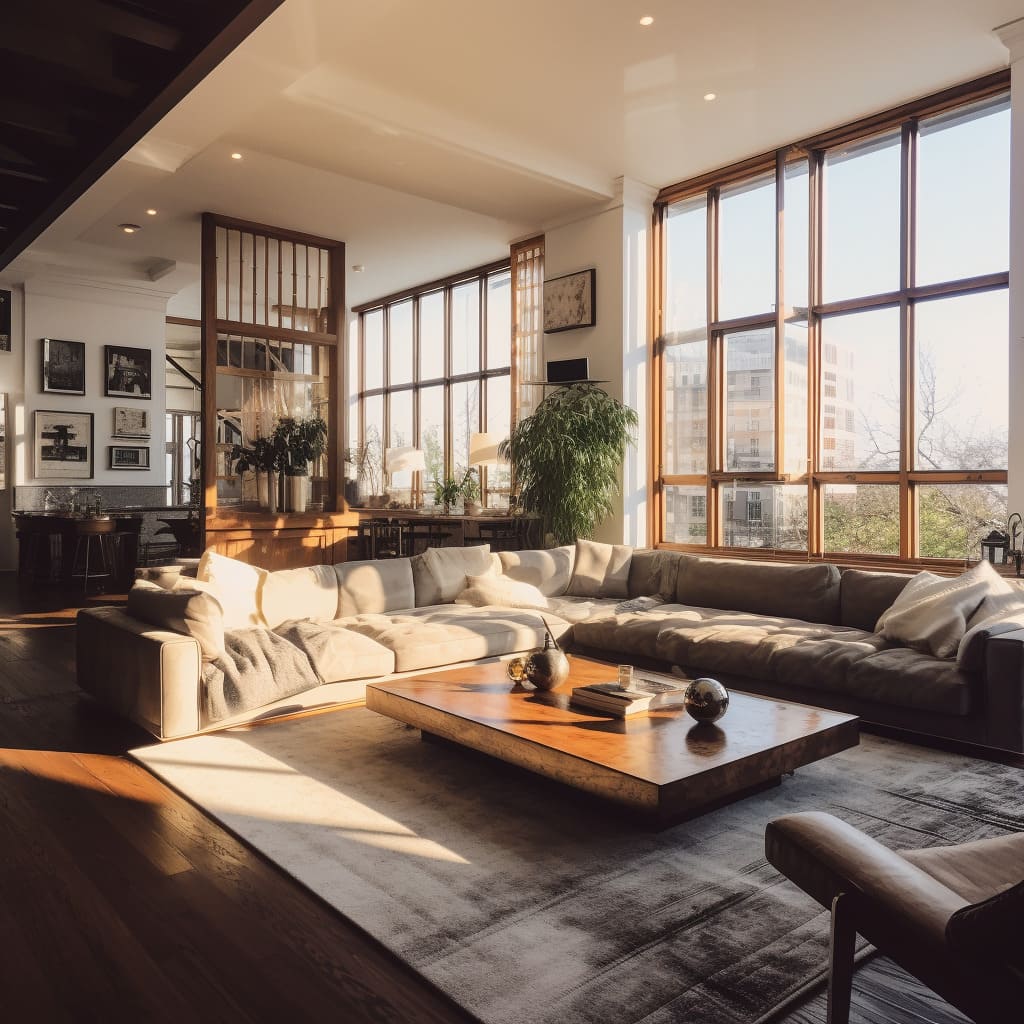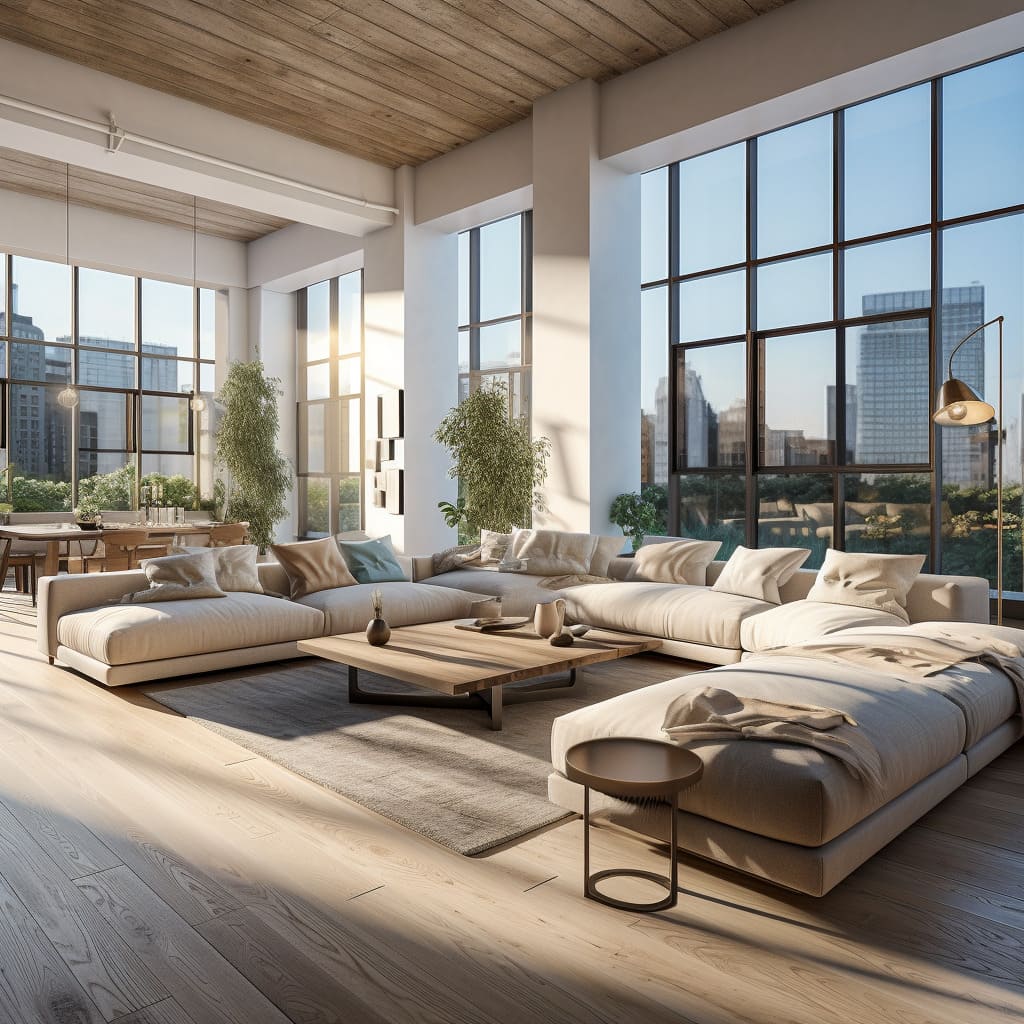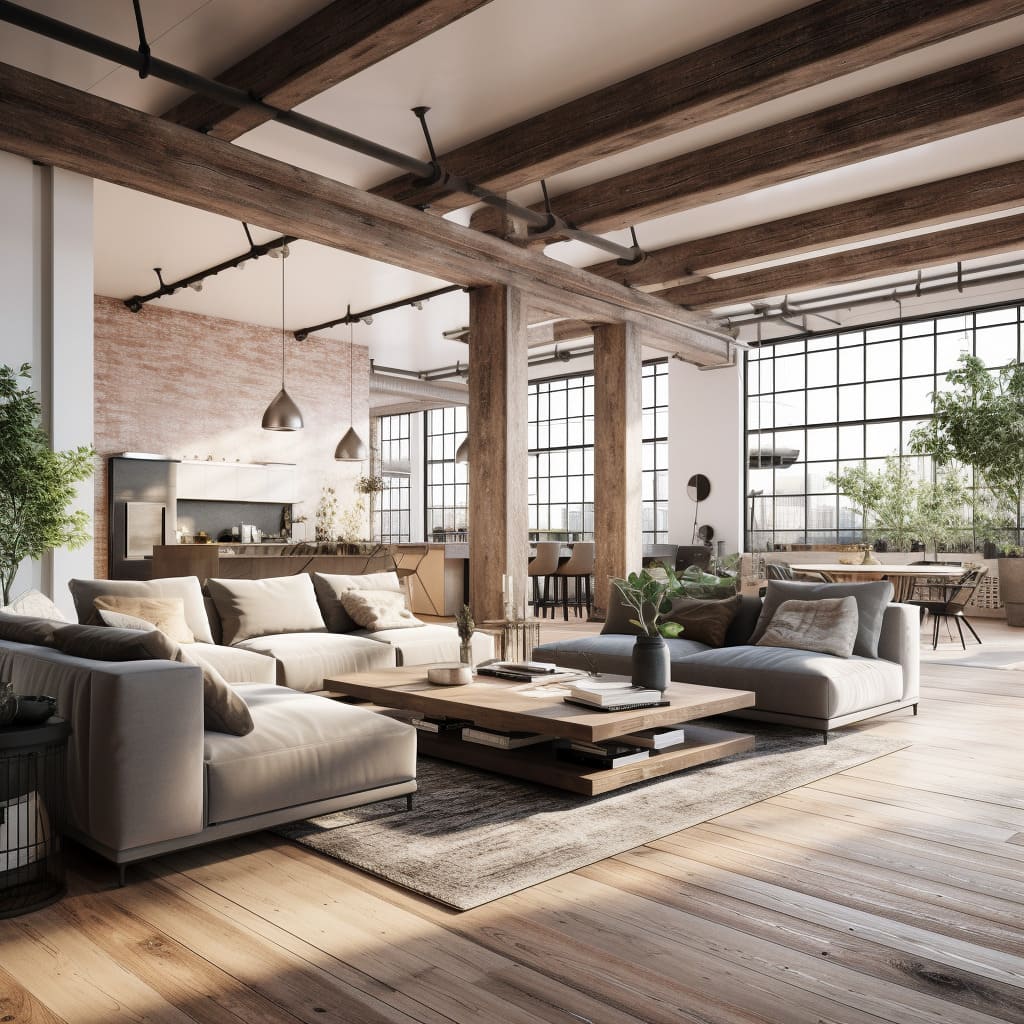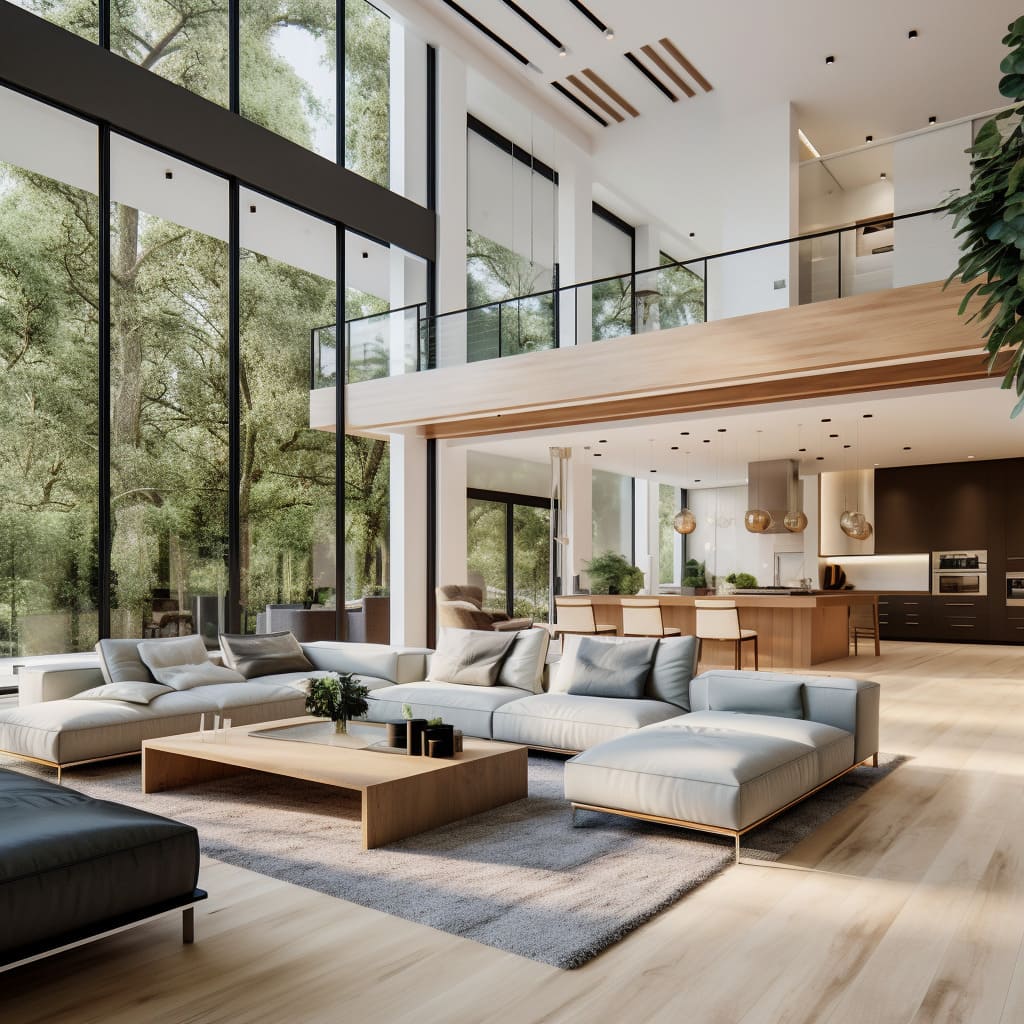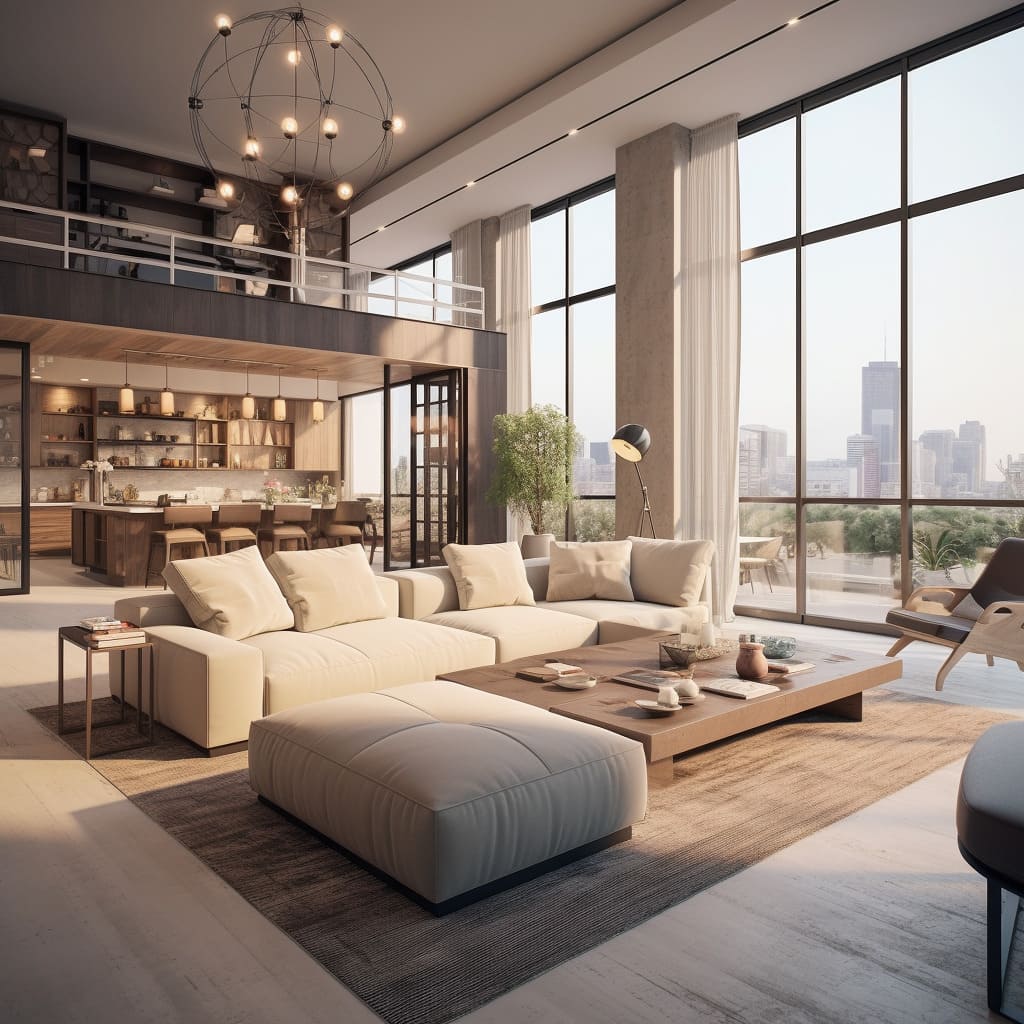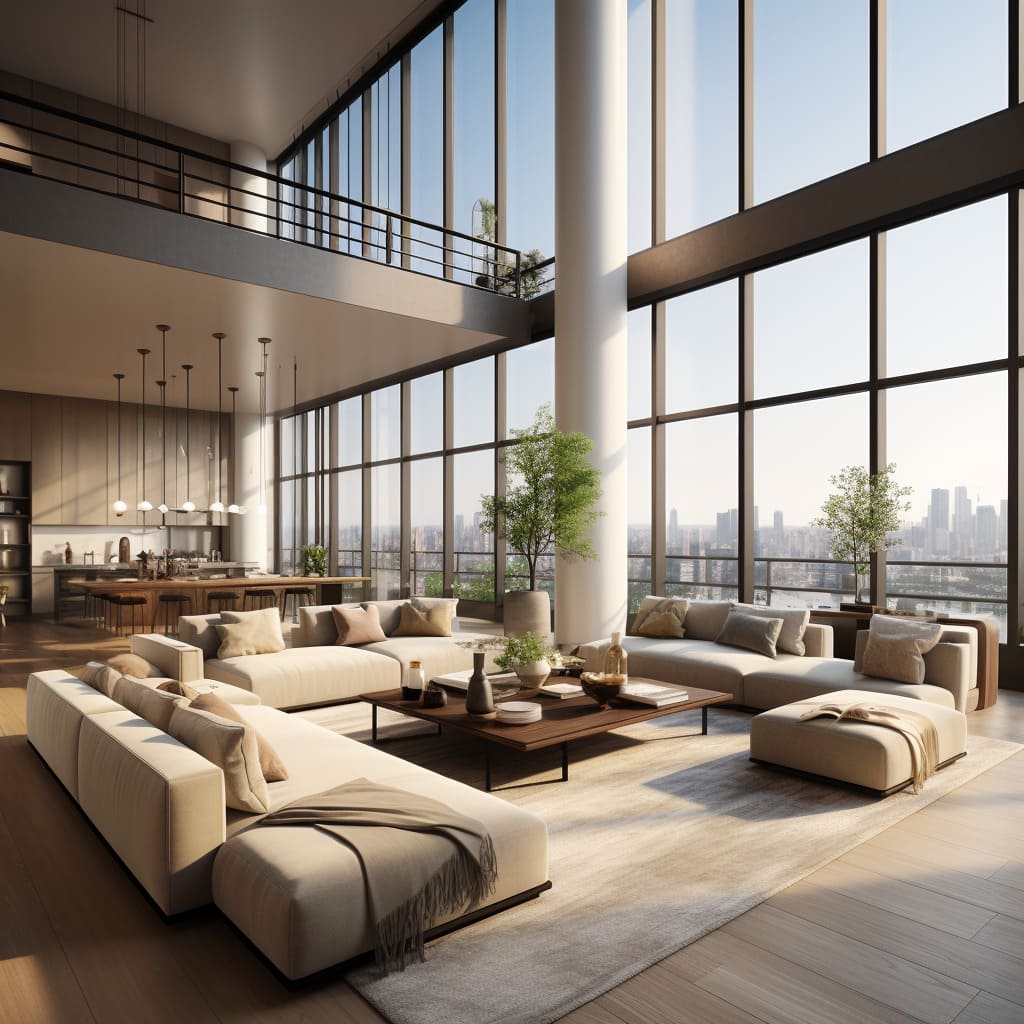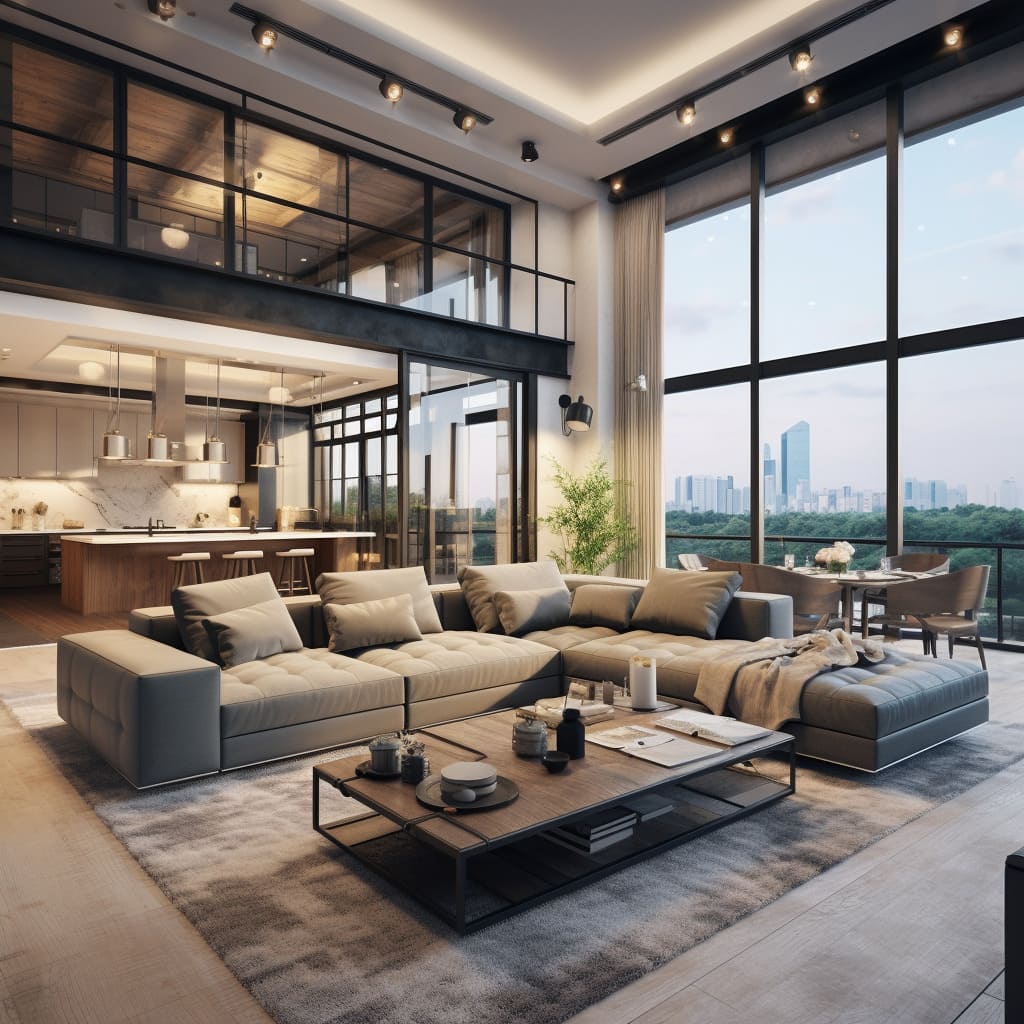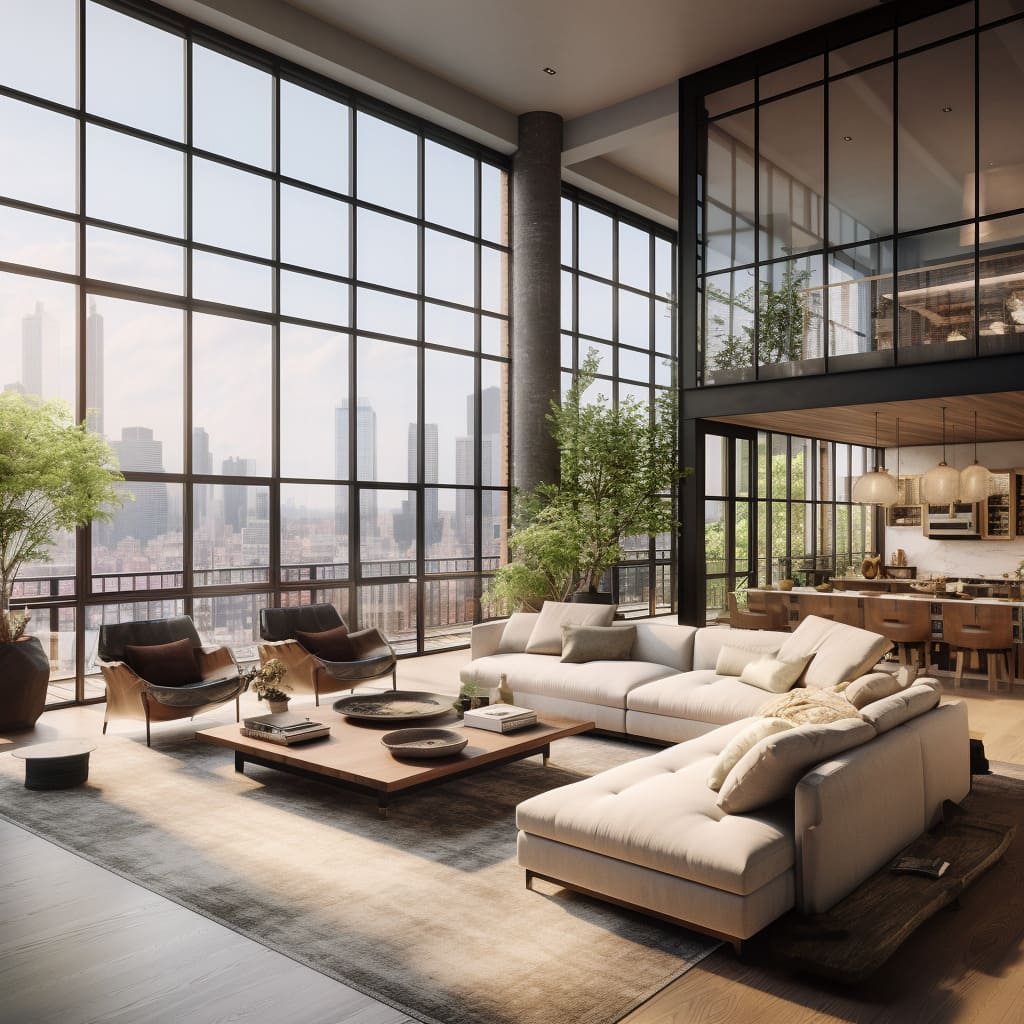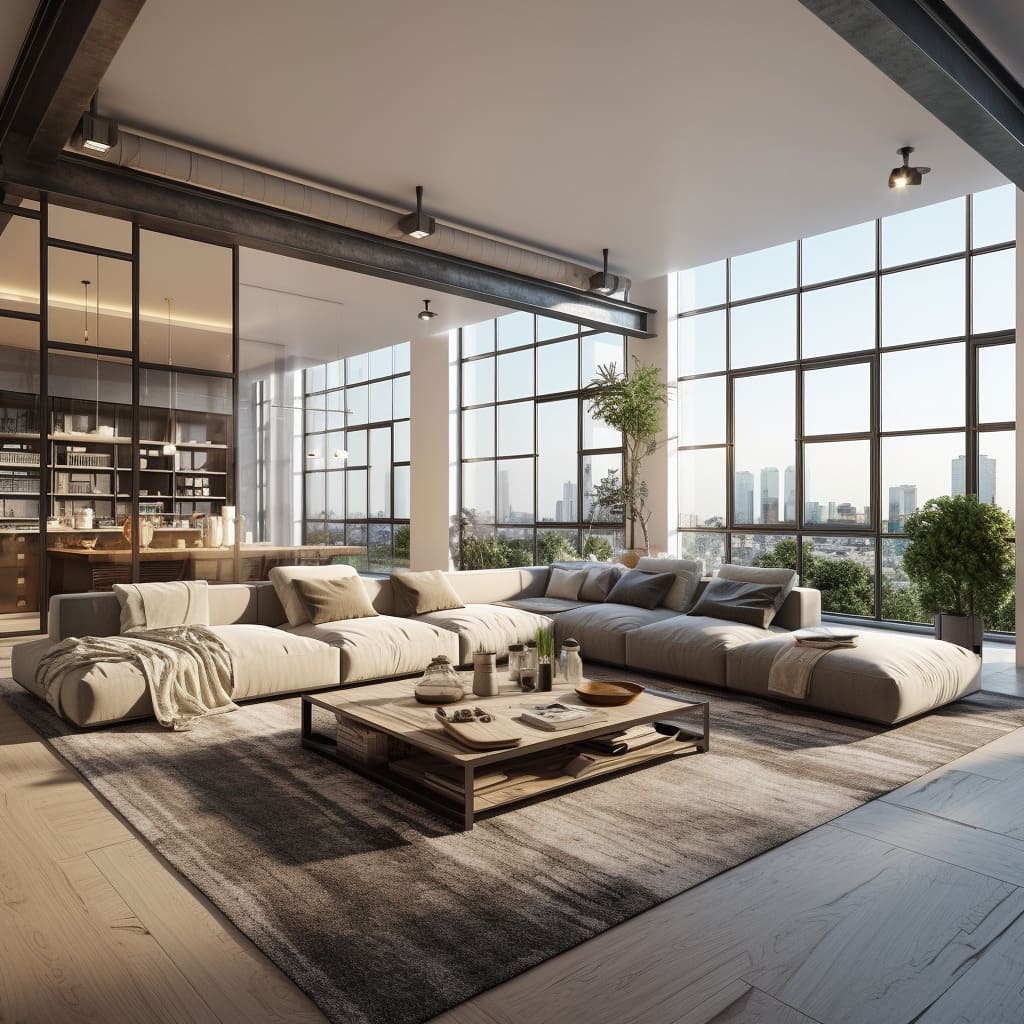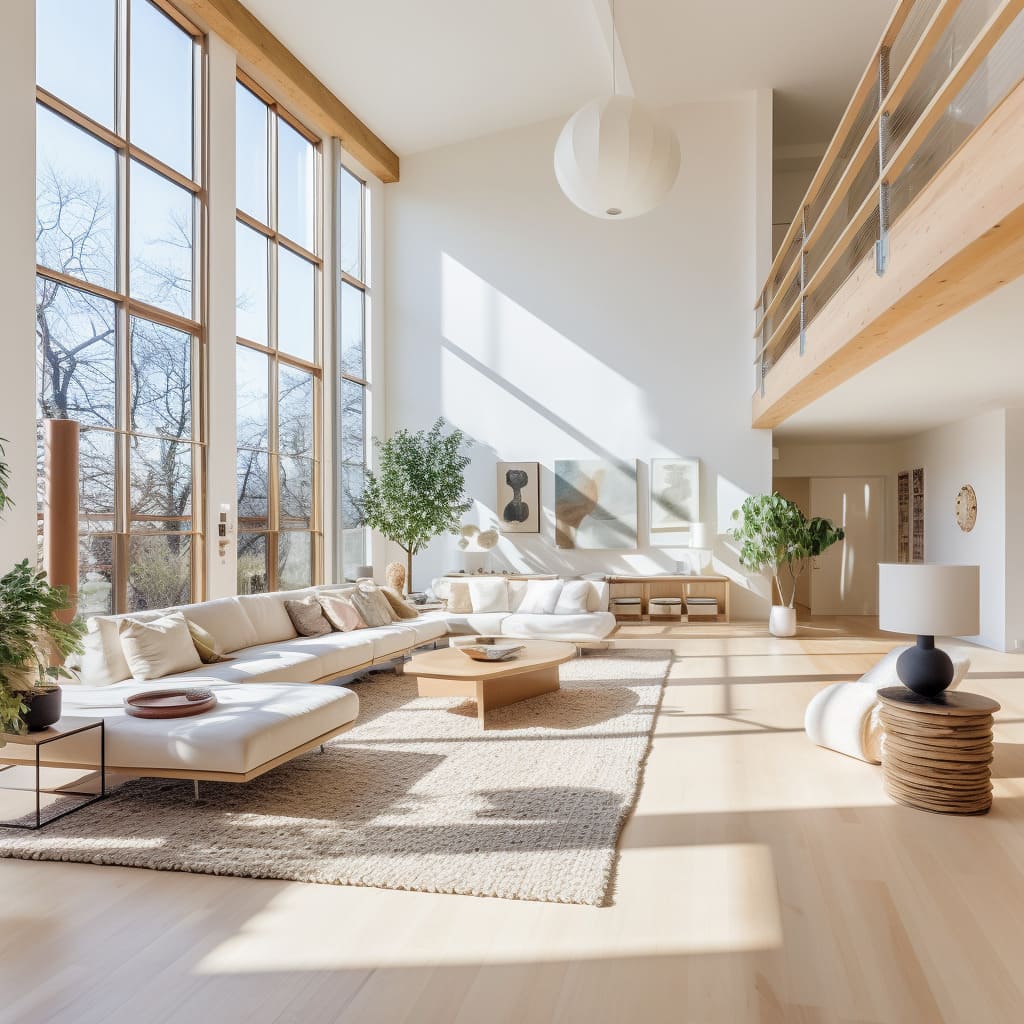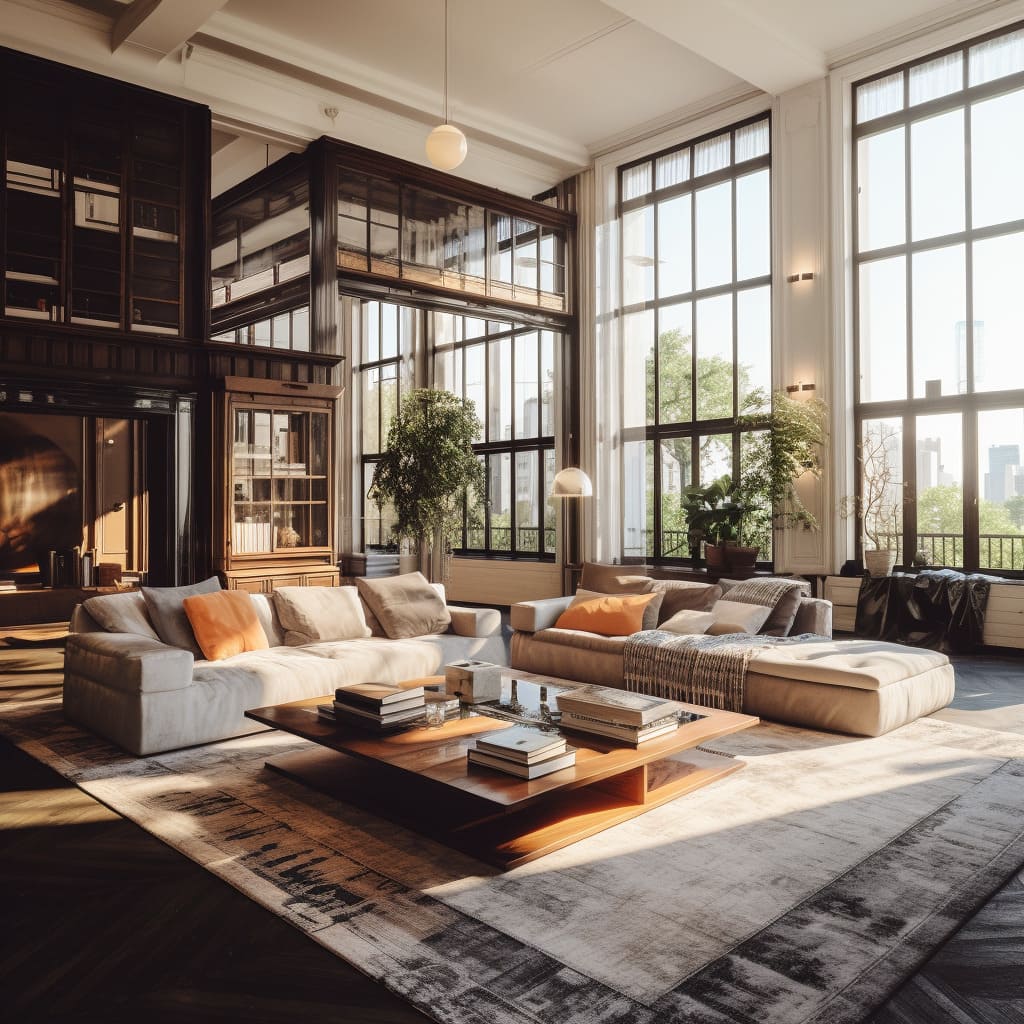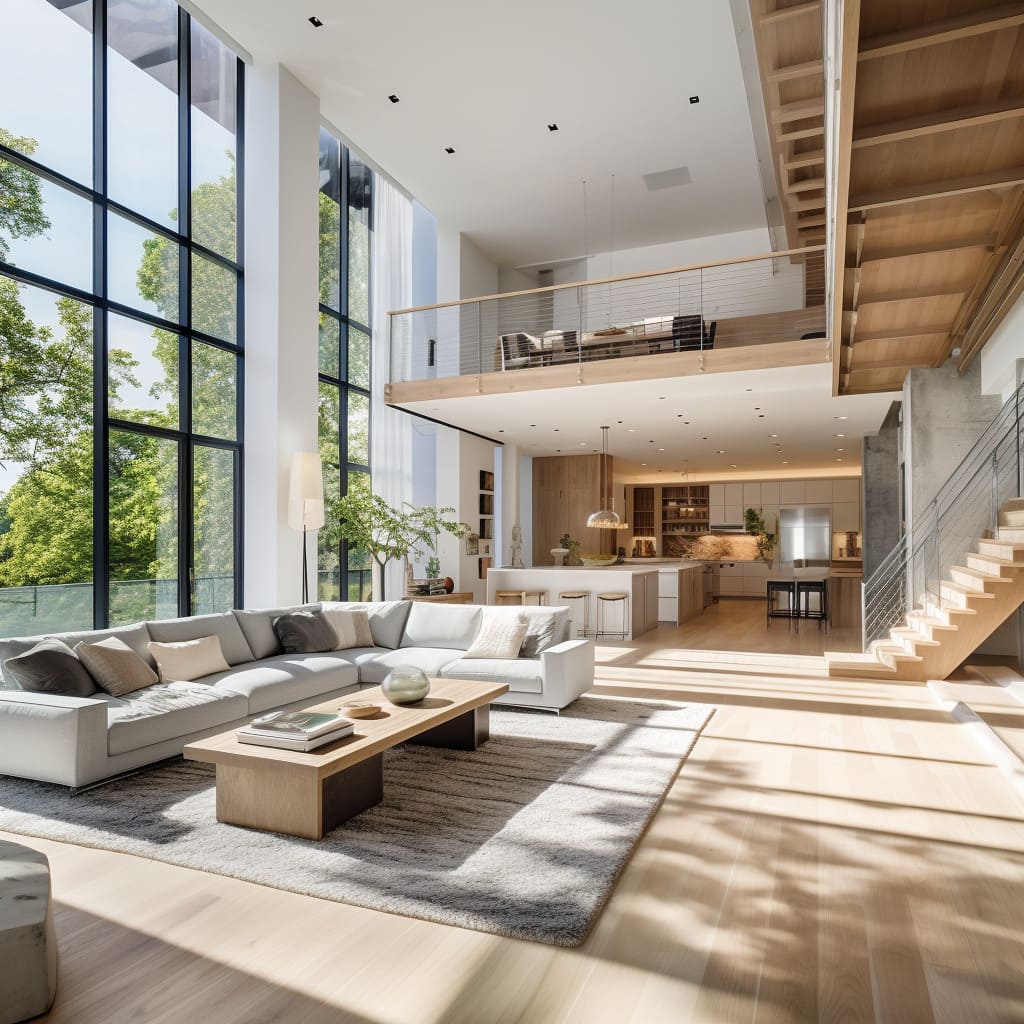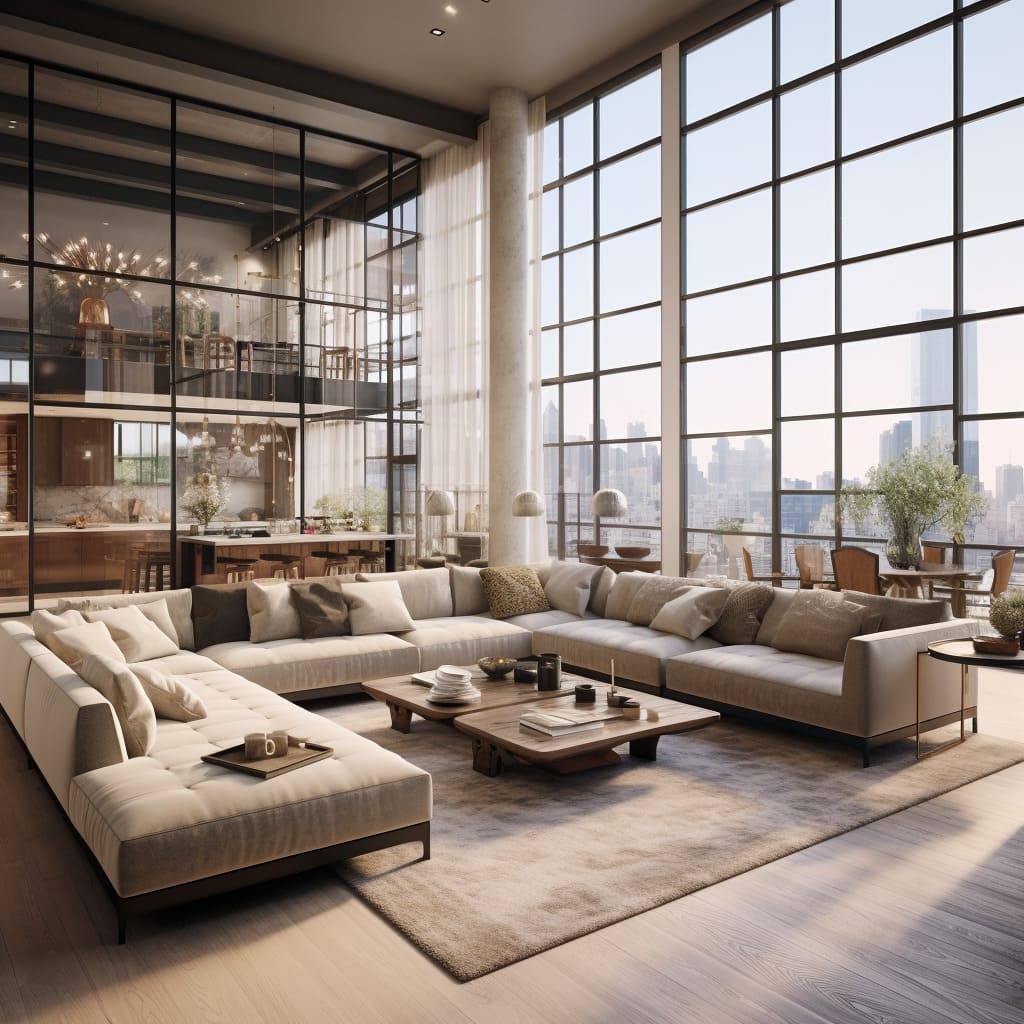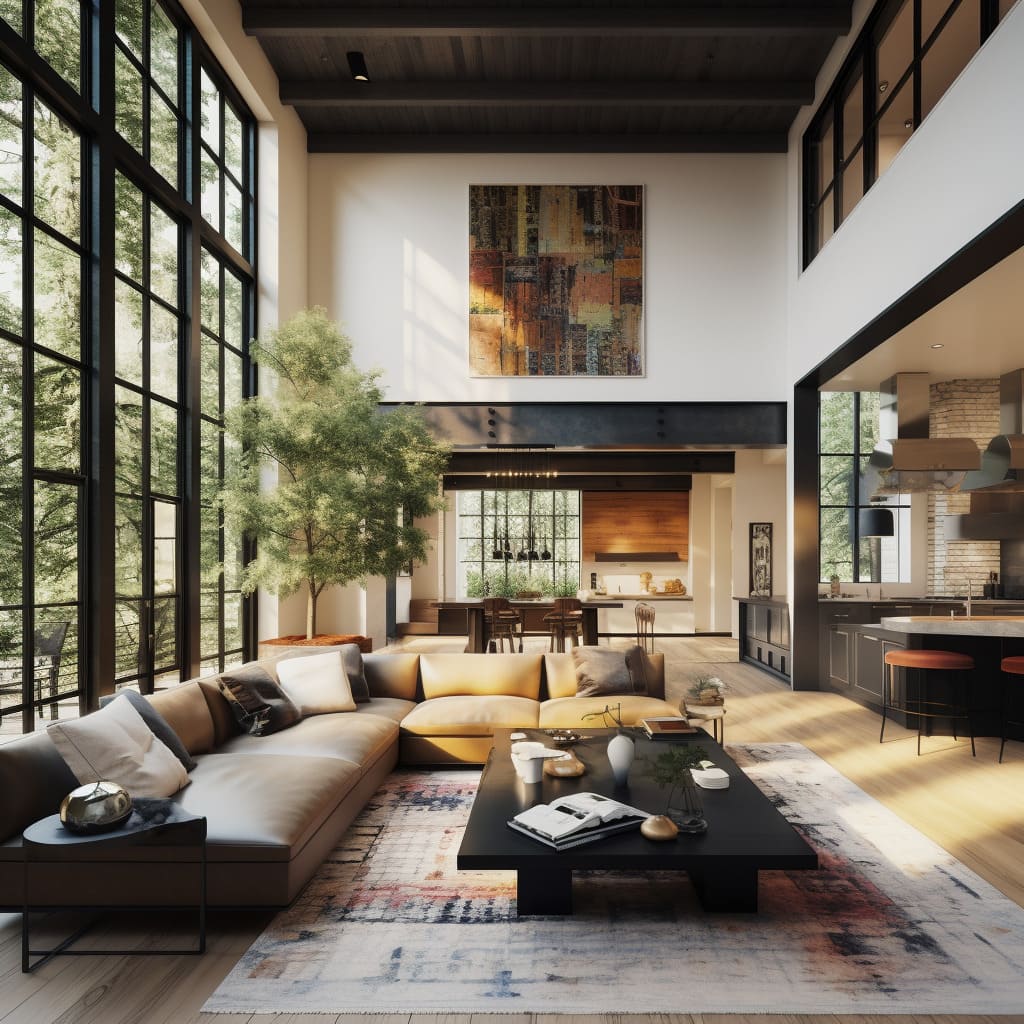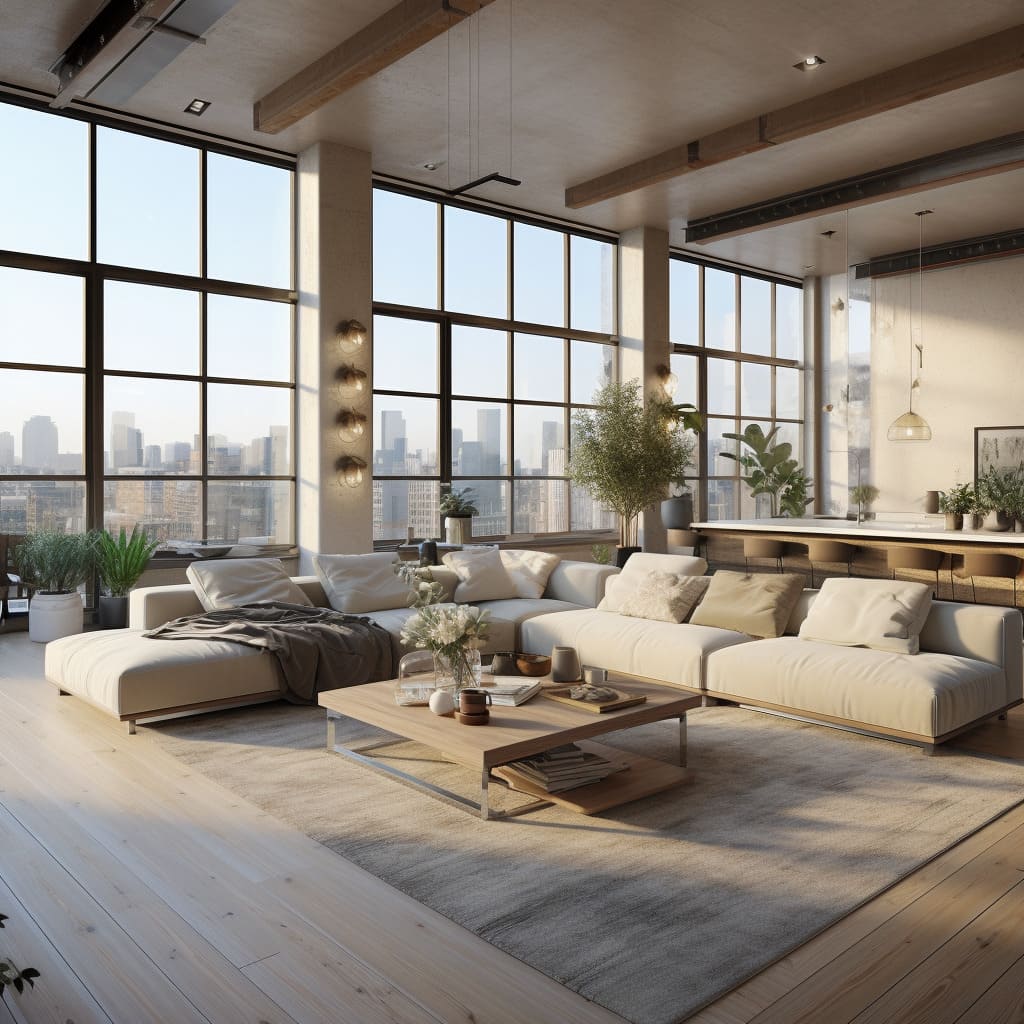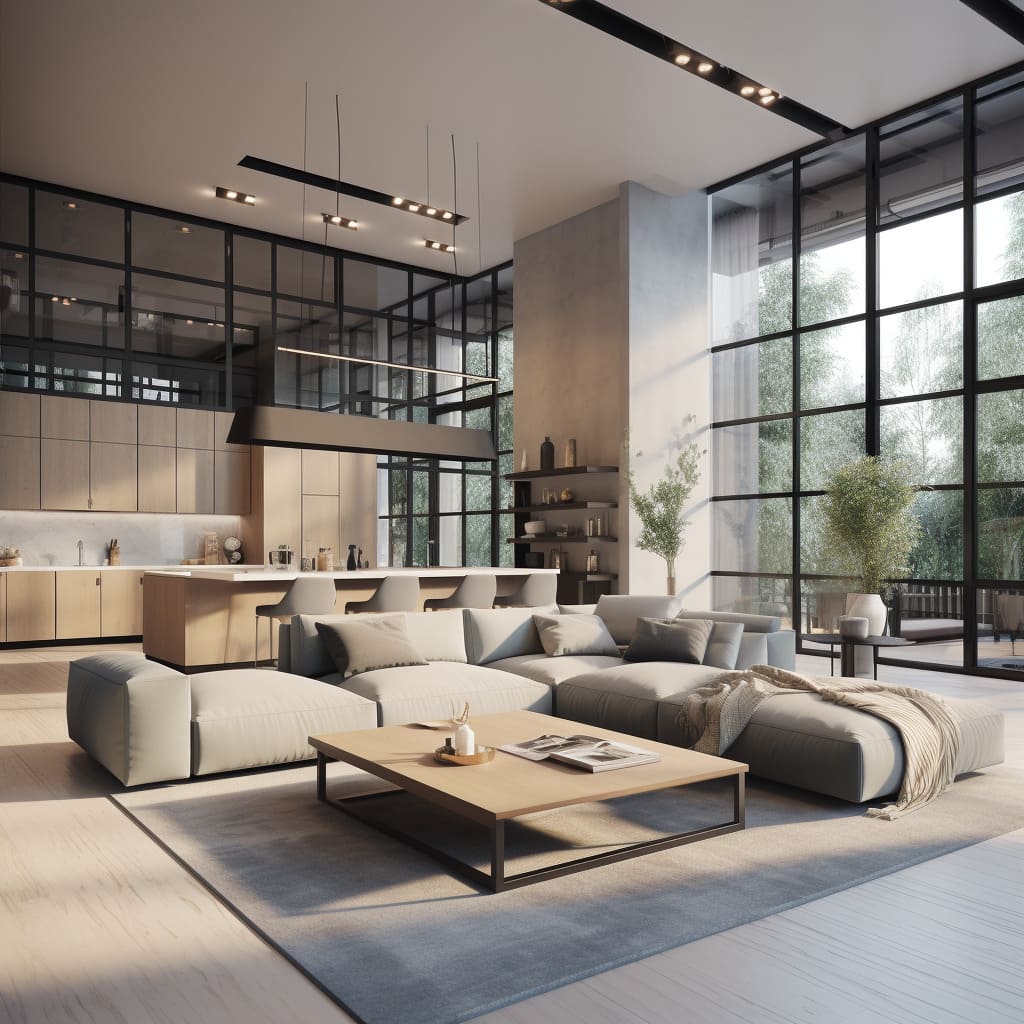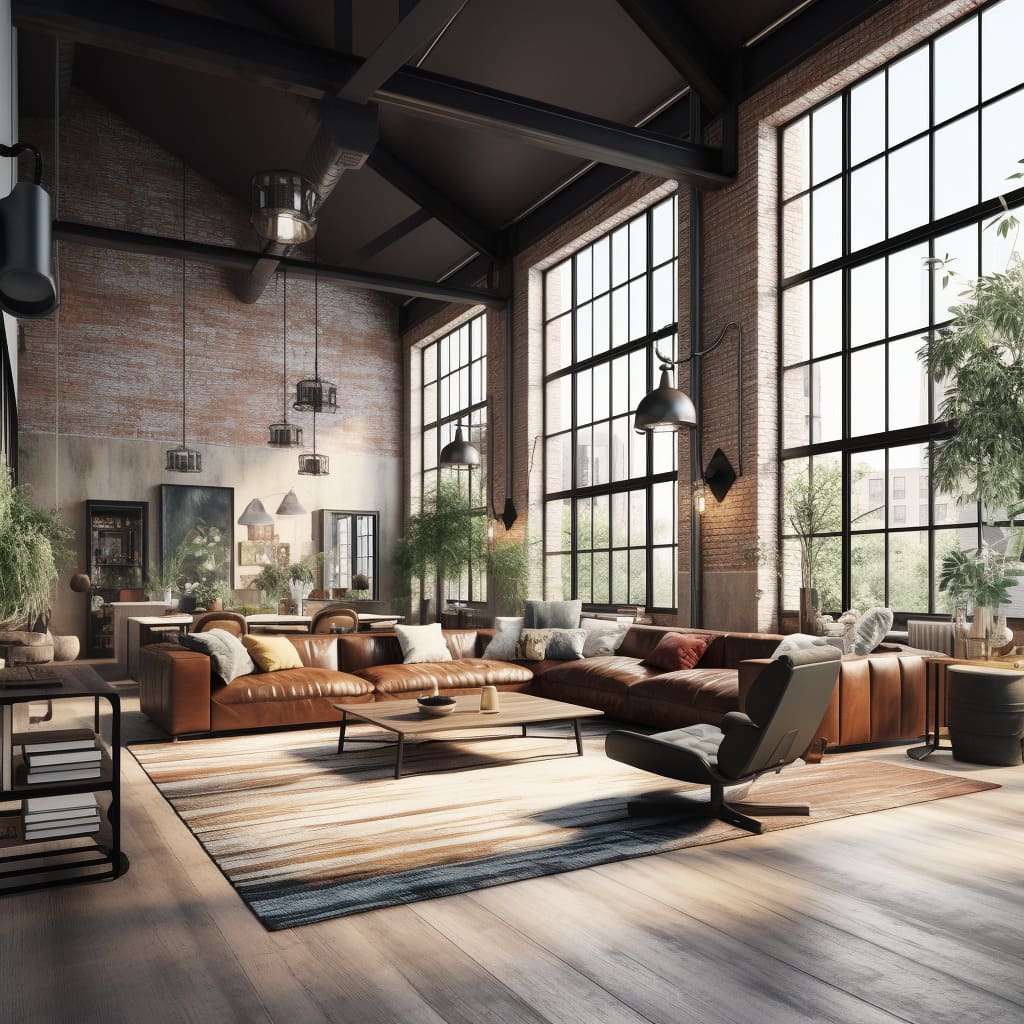Luxury industrial living rooms, it is where contemporary design meets urban elegance. This article delves into the essential components that define this popular aesthetic.
Key elements include:
Expansive Industrial-Style Windows: Large windows that not only offer breathtaking urban views but also flood the space with natural light.
Neutral Color Palettes: A serene blend of creams, grays, and beiges that create a calming atmosphere.
Comfortable Sectional Sofas: Plush, inviting furniture that adds a touch of luxury and relaxation.
Hardwood Flooring: Wide plank floors that provide a warm foundation and add organic texture.
Integrated Greenery: Plants that introduce vibrant, organic elements, contrasting with the industrial surroundings.
Architectural Features: Exposed ceiling beams and support columns that highlight the room’s structural beauty.
Strategic Lighting: A combination of functional and decorative fixtures that enhance the ambiance.
Personalized Bookshelves: Tall, built-in units that display curated collections and reflect personal tastes.
The industrial-style living room showcases a mix of old and new design elements.
Together, these elements craft a living space that balances rugged industrial charm with modern comfort, making it ideal for urban living.
Industrial Windows: The Heart of Industrial Chic Design
In industrial-chic living rooms, large industrial-style windows are key. They do more than just offer views of the city; they define the room’s character.
These windows let in plenty of light, making the space bright and welcoming.
The windows have black frames that stand out against the room’s lighter colors. This creates a striking visual effect.
Their grid-like pattern adds architectural interest and a sense of rhythm, reinforcing the modern industrial theme. These windows match well with other industrial features like concrete ceilings and visible beams.
They blur the line between inside and outside, visually enlarging the living area and linking it to the city.
Throughout the day, these windows transform with the changing light and weather, adding dynamism to the room. At night, they frame the city lights, turning the space into a picturesque scene.
This thoughtful blend of beauty and function highlights the essence of industrial-chic design, making the living space both attractive and practical.
Structural Elements
The architecture and materials play a crucial role in their overall design. Key features include exposed ceiling beams and support columns, which significantly shape the space’s character.
The ceiling beams, often finished in a dark hue, contrast with the lighter ceiling, highlighting the room’s height and complementing the industrial style of the windows. They also serve as a structural framework for lighting fixtures, contributing to the room’s intricate lighting design.
A central support column, typically wrapped in concrete or stone, enhances the industrial yet sophisticated look. Its placement and finish are not just structural necessities but are deliberately used to elevate the design.
This column introduces a raw texture that contrasts with the room’s smoother surfaces. These architectural elements are vital to the room’s identity, combining aesthetics with functionality.
They underline the industrial-luxe theme and visually anchor the space, showing a preference for materials often concealed in more traditional designs.
Comfort and Style
The open-plan area is often defined by a large, inviting L-shaped sectional sofa. This sofa, typically in a soft cream color, not only offers a relaxing space for entertainment and leisure but also serves as a stylish focal point.
It’s placed to allow clear views of the urban landscape through expansive windows and facilitates interaction with adjoining areas like the kitchen.
More than just furniture, this sofa is a symbol of comfort and elegance. Its substantial size beckons guests to relax in its plush cushions, enhanced by an assortment of throw pillows in neutral tones that echo the room’s color scheme.
The sofa’s fabric is both durable and soft, signifying a space meant for daily use without compromising luxury. It faces a sturdy, low-profile coffee table made of dark wood, contrasting with the light flooring to create a warm, welcoming ambiance.
Above the kitchen island, spherical pendant lights add a modern, artistic flair. This lighting not only brightens the room but also acts as a decorative piece, drawing attention to the high ceilings and the open, spacious feel of the living area.
Overall, the blend of the cream sectional, the panoramic city views, the warm wooden elements, and the innovative lighting design culminates in a living space that is both practical and visually stunning, perfectly embodying the essence of modern urban living.
The Warmth of Hardwood Floors
In industrial style, the flooring is a significant aspect that deserves attention. Wide plank hardwood floors provide a natural and inviting foundation that complements the neutral color scheme, adding an organic texture to the overall design.
These floors are often finished in a light, natural tone that catches sunlight and brightens the room. Their width enhances the feeling of spaciousness, drawing the eye across the space and making it appear larger.
The light wood maintains an open, airy atmosphere, aligning with other natural elements in the room for a unified look.
The visible grain and knots in the wood add character and depth, showcasing a design preference for materials that bring a sense of nature inside. A modern, matte finish ensures that the flooring doesn’t overpower other room elements, like the plush sofa, coffee table, and shelving.
Overall, this type of flooring is more than just a surface; it’s a fundamental part of the room’s design. It anchors the furniture and decor, contributing significantly to the warm, welcoming feel of the home.
It embodies the design philosophy of blending modern, industrial aspects with natural, tactile materials, creating a space that is both stylish and comfortable.
Lighting Design in Industrial Interiors
Lighting is a blend of function and decoration, shaping the room’s mood and style. Key features include elegant pendant lights that hang over kitchen islands.
These lights, set at various heights, offer both practical illumination and artistic expression, creating a captivating focal point.
The track lighting system, running along ceiling beams, aligns with the industrial theme. Its versatility allows for targeted lighting across different areas, enhancing the room’s functionality and visual appeal.
In the kitchen, under-cabinet lighting adds another dimension of light. It provides a practical work light while offering a soft contrast to the more direct lighting of pendants and tracks.
This multi-layered lighting approach ensures each part of the room is appropriately lit, contributing to a welcoming atmosphere.
The Bookshelf: A Cultural Centerpiece in Industrial Designs
This tall, built-in unit, often colored in a dark shade, complements the room’s industrial style. It reaches towards the ceiling, functioning both as a practical storage space and a display showcasing the resident’s tastes and interests.
The shelves are filled with books of different sizes and topics, indicating an intellectual ambiance. Decorative items like vases, bowls, and sculptures are interspersed among the books, adding variety and personality.
The arrangement of these items—some vertical, others horizontal—creates a dynamic, visually engaging display.
This bookshelf not only breaks up the room’s expansive walls but also provides a contrast to lighter tones around it. It’s a cultural statement, revealing the owner’s interests and offering guests a glimpse into their world.
The presence of a large, well-styled bookshelf demonstrates a love for literature and art, integrating these elements into everyday life in a meaningful way.
Bringing Nature Indoors
Integrating plants into living rooms offers a refreshing contrast to the urban aesthetic. Greenery introduces a vibrant, organic touch that softens the industrial elements, bringing life to the space.
Large potted plants are placed thoughtfully around the room. Their lush foliage adds color and vitality to the neutral tones.
These plants, varying in size and species, sometimes stretch up to the windows, blurring the line between the indoor space and the cityscape outside.
Beyond their aesthetic value, these plants also act as natural air purifiers, enhancing the well-being of residents. This use of greenery cleverly creates natural divisions in the open-plan area and adds texture.
The selection of plants is not just for their beauty but also for their indoor growth suitability, showing a balance between design and practicality.
The presence of these plants brings a sense of tranquility and a piece of nature into the urban home, making the space feel more welcoming and alive.
In conclusion, luxury industrial living room design masterfully blends various elements to create spaces that are both stylish and functional. The large, industrial-style windows frame stunning urban views and fill the room with natural light, enhancing the open and airy atmosphere.
The use of neutral color palettes, along with the comfort of plush, sectional sofas, offers a serene and inviting environment. Hardwood flooring and the inclusion of greenery add warmth and vitality, contrasting with the raw, industrial features.
Key structural elements like exposed beams and support columns contribute to the aesthetic, emphasizing the space’s architectural character. Thoughtful lighting, ranging from elegant pendant lights to practical track systems, creates a dynamic and cozy ambiance.
Bookshelves filled with personal artifacts add a cultural dimension, making the space more intimate and reflective of individual tastes.
This style epitomizes a balanced approach to design, where modern luxury meets industrial robustness. It celebrates the beauty of raw materials and structural elements, while maintaining a comfortable, livable space.
Industrial-chic living rooms are not just visually appealing; they are a testament to the harmonious blend of form, function, and personal expression in interior design.

